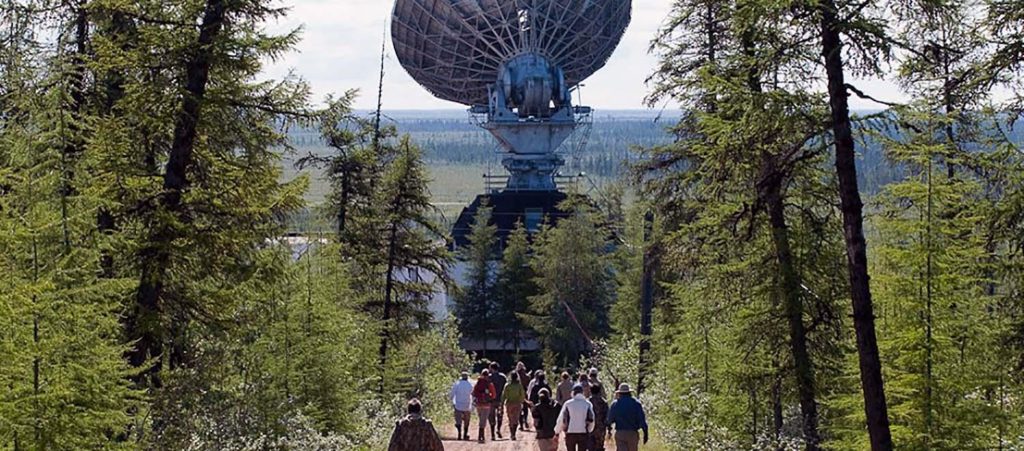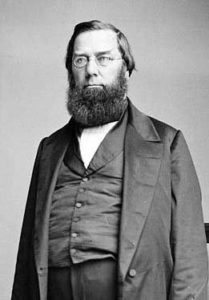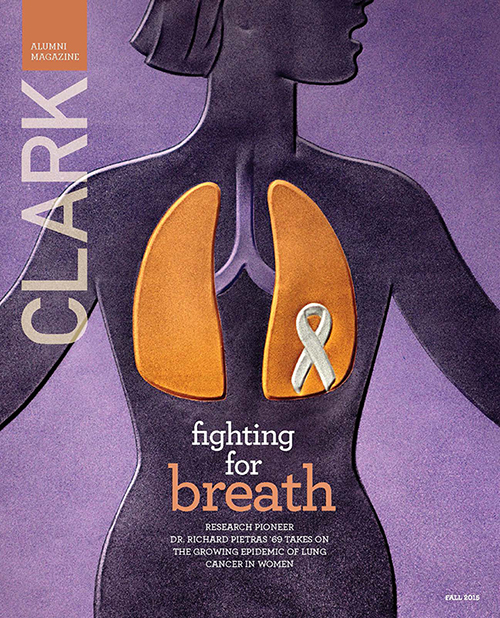A world of difference

George Perkins Marsh was a 19th-century Renaissance man — linguist, ambassador, legislator, and lawyer — who, during his extensive travels, kept records of how humans were changing the natural environment. He captured his observations and reflections in the 1864 book “Man and Nature, or Physical Geography as Modified by Human Action,” a title that hardly screams “page-turner” today, but which was a bestseller in its time.

Marsh was more than just an observer of his world, he was a visionary. At least as far back as Plato, people noted how mankind modified local environments. George Perkins Marsh went a step further by recognizing that altering the landscape can also alter human destiny — he connected the dots.
“It’s not until the middle 1800s that we start to see things that we can associate with modern concepts of environmental sustainability,” says Robert Johnston, research professor and director of the George Perkins Marsh Institute at Clark University. “Marsh made the point that humans were making large-scale changes in the landscape that were ultimately affecting human welfare, often in a negative way.”
To that end, the work of the Marsh Institute is informed by a fundamental question: What is and ought to be our relationship with nature? The institute uses both fundamental and use-inspired research to help answer this question.
These interactions can range from a gross exploitation of nature’s resources without thought for the future, to passive acceptance of whatever Mother Nature dishes out. However, what we as a society choose to value, and how we choose to act on those values, determines our position along that continuum. The institute’s approach, as expressed in its inaugural publication, is to find “George Marsh’s middle path between unbridled economic opportunism and ‘Earth First’ extremism.”

Earlier this year, “The Allegheny Front,” a Pennsylvania-based public radio program, contacted Yelena Ogneva-Himmelberger, Ph.D. ’98, a Marsh Institute research associate professor and faculty member in the Department of International Development, Community, and Environment. The producers were creating a multi-part series called “The Fracking of Pennsylvania,” and had come across her recently published investigation into whether the location of fracking wells in the Marcellus Shale regions of Pennsylvania, Ohio, and West Virginia, along with the alleged accompanying pollution, disproportionately affected vulnerable populations.
Ogneva-Himmelberger found a correlation between some well locations and the impact on residents in lower socio-economic circumstances, earning the attention of a fracking industry trade publication that derided her study, claiming it was underpinned by a “cockamamie theory of environmental justice.”
In short, the work of a Marsh Institute scientist gets noticed.
Here’s further proof:
When Canada’s Standing Parliamentary Committee on Foreign Affairs and International Development needed an expert witness to inform its policy on international development and mining, it sought out Anthony Bebbington, M.A. ’88, Ph.D. ’90, a Marsh research professor, director of the Clark Graduate School of Geography, and a member of the National Academy of Sciences.
When a U.S. Senate subcommittee required scientific testimony during debate of a proposed bill for reducing the risk of catastrophic wildfire, it called on research associate professor Dominik Kulakowski.
When the National Research Council assessed the stock-rebuilding efforts resulting from the 2006 Fishery Conservation and Management Reauthorization Act, it appointed Robert Johnston to the review committee.
Organizations of all stripes — public and private, domestic and international, local and national — draw on the expertise of Marsh Institute scientists to provide the information necessary to help us negotiate our fraught relationship with the environment. By doing so these groups are also helping the George Perkins Marsh Institute fulfill its mission to promote sustainable environments for the public good by increasing our understanding of the systems — natural, technological, and socioeconomic — that link us with the natural world, and by making that knowledge available to policymakers and stakeholders.
*****
The Marsh Institute’s work is driven not by the research agendas of particular academic disciplines but by a dizzying assortment of urgent real-world challenges, Johnston says. Established in 1990 and housed in the two historic Norcross houses at the north edge of campus, the institute grew out of earlier research clusters at Clark that focused on topics like environmental risk and hazards, the potential of computer technology and remotely sensed imagery to map and analyze the environment, and the ways humans have shaped and are shaped by nature.
In fact, the Marsh Institute is home to one of the premier environmental research libraries in the nation.
Consider some of the questions that today’s Marsh researchers seek to answer:
- How can communities best adapt to the coastal flooding and other hazards that come in the wake of climate change and sea-level rise?
- Is there a way to ensure that chemicals used to bolster agricultural yields and produce consumer goods don’t poison us?
- How do we manage consumption while preserving quality of life?
- How do we ensure that sustainability strategies are just and equitable?
Ensuring sustainable environments for the common good requires the perspectives of multiple disciplines. This is the very definition of the Marsh approach, which values input from scientists who study the physical processes of earth systems and social scientists who shed light on human behavior and decision-making. Not only does the institute host approximately 50 research professors and scientists, with specialties that include biology, chemistry, environmental science, geography, and economics, but the scientists’ individual credentials often span disciplines. Most of the researchers come from within the ranks of Clark University’s academic departments.
A good example of the Marsh Institute ethos can be found in its new assistant director, Dana Bauer, whose academic degrees run the gamut from industrial engineering and information systems to environmental policy and natural-resource economics. Bauer, who describes herself as “a non-traditional academic” because she refuses to focus on a single area, finds Marsh’s problem-focused, multidisciplinary community a perfect match. Public and private organizations are increasingly looking for experts who can cross disciplinary boundaries with such ease — giving Bauer a clear advantage whether she is writing grant applications to federal agencies or foundations, or speaking to government officials.
“Coming to a place like the Marsh Institute, I can use my broad training and draw on all those tools to come up with solutions to environmental problems,” she says. “From my training as an engineer, I’m a systems thinker — I’m pretty good at looking at the whole picture and how the pieces fit together.”
The institute extends its reach by collaborating with other organizations, both inside and outside the academy.
“Much of the institute’s research is done with other partners, often bigger partners,” says Clark University Dean of Research Nancy Budwig. “Marsh scientists might be responsible for a piece of a much larger grant. For scientists at a small university like Clark that can be a very successful way to work — one that allows our researchers to draw upon the advantages of Clark’s small scale, while at the same time leveraging some of the advantages of a much larger-scale research project.”
Budwig notes the level of student engagement at Marsh (and Clark’s other research centers) is impressive for a university of Clark’s size. Marsh researchers involve students deeply in the institute’s scholarly life and work. While the participation of graduate students in Marsh’s use-inspired research exemplifies the University’s hallmark of engaged scholarship, the institute also funds undergraduate research opportunities with the Albert, Norma, and Howard ’77 Geller Endowed Research Award and the National Oceanic and Atmospheric Administration Student Fellowship, the latter providing summer opportunities in NOAA labs around the country in partnership with the Mosakowski Institute for Public Enterprise.
Research professors Deborah Martin and John Rogan — also faculty members in the Graduate School of Geography — lead Clark’s Human-Environment Regional Observatory (HERO) program, which has received funding from the National Science Foundation, providing opportunities for undergraduate students to conduct research on human-environment relationships. The program is currently focusing on the socio-ecological impacts of the Asian Longhorned Beetle infestation and tree replanting program in central Massachusetts.
Problem-solving at this level doesn’t happen without financial support. Johnston notes that, at a time when money for scientific research is contracting, the institute directs its research to pressing current issues for which funding is more likely to be available. “Marsh scientists are often invited to apply for grants. We’re competing against the best in the world for funding — and succeeding,” he says. “We succeed because we go where problems need to be solved, unconstrained by narrow research agendas.”
It’s a strategy that benefits not just the institute, but the University as a whole. When Marsh research delivers high-quality, useable results, Clark is put on the radar of policymakers, agencies, and media, as well as prospective faculty and graduate students. Budwig and Johnston agree that it also gains the attention and respect of scientists and experts worldwide, giving Clark an outsized influence that belies its relatively small size as a research university.
According to Johnston, the support gleaned by the Marsh Institute comprises more than a third of the University’s total grant revenue. For example, Marsh researchers Karen Frey, a Graduate School of Geography associate professor studying changes in polar ice under climate change, and Christopher Williams, another Graduate School of Geography associate professor studying how earth’s biosphere responds to natural and human disturbances, are two of Clark’s most productive and recognized faculty in grant-supported research.
*****
Choosing the path of sustainability assumes the need to make tradeoffs that satisfy our needs and wants while preserving the resources necessary to the lives of future generations, as well as our own. Marsh Institute researchers insist that making informed tradeoffs is key, and requires we value all that nature provides — from tangible products to aesthetics. For example, Bauer knows that to evaluate whether habitats for bees, bats, and birds should be preserved, it’s important to factor in the critical, but often unacknowledged, contributions those species make to agricultural production. Her current research aims to assign a monetary value to those contributions.
Johnston and his research team were called upon by the Delaware Department of Natural Resources and Environmental Control to help think through a dilemma: Did it make sense for the state to keep repairing several eroding beaches on Delaware Bay that threatened adjacent homes? Johnston’s team helped the department assess and balance the costs and benefits of different courses of action, which included letting nature take its course until the houses fell into the water, buying out and/or relocating affected homeowners, and restoring the beaches year after year for an indefinite period of time.
In Johnston’s experience, using cost-benefit analysis to weigh alternatives can be both illuminating and, frequently, surprising. “In the Delaware case,” he says, “it turned out the option netting the greatest social benefit was to do nothing. Just let the water come in and those homes fall into the water. It’s not politically a particularly attractive option, and surely has ethical consequences that need to be considered, but from a pure economic and social-benefits perspective, it turns out that was the best thing.”
Johnston says more inclusive and informed decision-making to address environmental problems is not just fairer but ultimately more sustainable. In his research on how seaside towns adapt to coastal flooding, Johnston incorporates the views and values of a range of residents, not just those vocal few who attend town meetings. He and his team help decision-makers understand the value that the public holds for environmental assets like beaches, coastal marshes and open space. Often these assessments are at odds with what these decision-makers had assumed their constituents wanted, and this eye-opening information helps shape an acceptable response.
There’s no way of knowing for certain how George Perkins Marsh would have regarded Johnston’s research, or the work of the institute that bears his name, though he likely would be pleased. The Marsh Institute continues to reaffirm his theories about the need for humans to seek balance with their surroundings, pursue a course based on shared values, and keep connecting those dots.
Research projects at the Marsh Institute
Call of the rewild
When it comes to dealing with nature, we often act like we’re the only species on earth. But some, like research scientist William Lynn, are keenly aware that humans aren’t the only sentient creatures sharing the planet.
“Who is sustainability for?” he asks. “Do living things like animals and ecosystems have moral value? I think they do. Sustainability is for all of us — people, animals, and nature alike.”
Lynn works on ethics and public policy with an emphasis on animals, the environment, and sustainability. Not long ago he was called in by the U.S. Fish and Wildlife Service to help resolve a painful dilemma. The Pacific Northwest’s renowned northern spotted owl, endangered by habitat loss resulting from timber harvesting, was again under attack, but this time from a related species. The barred owl was encroaching on spotted owl territory and jeopardizing the spotted owl’s recovery. Should the USFWS intervene to even up the odds, especially when that meant killing hundreds of barred owls?
Lynn sanctioned an experiment to thin the barred owl populations around spotted owl habitat on the grounds that, because humans had endangered the spotted owl by destroying its habitat, humans had a responsibility to help the species try to survive in the wild. Even so, he remains very concerned that this experiment not be made into a policy of indiscriminately hunting barred owls. “Barred owls have moral value, too, and we cannot kill our way back to biodiversity. In the long run, restoring habitat and finding non-lethal alternatives is the only ethical answer.”
More recently, Lynn has lent his support to “rewilding,” increasing the presence of natural habitats to as much as 50 percent of the earth’s surface, on the grounds that as well as improving our quality of life, rewilding respects other species’ right to exist. Lynn’s article “Setting Aside Half The Earth For ‘Rewilding’: The Ethical Dimension,” originally published in theconversation.com, was republished by several major media websites: time.com, iflscience.com, and theecologist.org.
A matter of chemistry
Marsh Institute research professor and Stanford-trained geneticist Dale Hattis, along with nine other colleagues on the U.S. Toxicology Program’s Board of Scientific Counselors, advises on the risk to human health of chemicals that people might breathe, ingest or otherwise come into contact with. Our bodies are continually exposed to seen and unseen chemicals, more than 80,000 of which are registered for use in the United States, according to the program’s website.
For decades the agriculture industry has relied on pesticides, herbicides, and fungicides to kill vermin and other organisms that compete for the fruits, vegetables, and grains needed to feed earth’s more than seven billion people. Other industries use or manufacture a wide range of chemicals to produce the energy and goods that allow us to maintain a comfortable standard of living. Those chemicals pose potential hazards to humans.
Hattis’ passion for sifting through evidence, combined with a deep understanding of how the human body functions at the molecular level, positions him to evaluate complex research studies and influence the decision on whether a chemical should be approved for use, or whether uses should be modified in various ways to reduce exposures.
Enabling smart consumers
Some natural resources, like timber, might be sustainable if managed carefully. Others, like oil, are finite. Nonetheless, even their availability might be prolonged through the implementation of thoughtful consumption strategies. The Marsh Institute’s husband-and-wife team Philip Vergragt and Halina Brown pose a question: “Can we come up with policies or technological changes that deliver human well-being and are not based on perpetual consumerism?”
Taking their cue from a similar organization in Europe, Vergragt and Brown have collaborated with Maurie Cohen of the New Jersey Institute of Technology, to create the Sustainable Consumption Research and Action Initiative. SCORAI describes itself as a global “knowledge network of academics and practitioners working at the interface of material consumption, human well-being, and technological and cultural change.” Through conferences and workshops, its members explore the possibility of transitioning beyond the consumer-dominant society.
For instance, in October 2014, SCORAI co-hosted a workshop, “The Role of Cities in Advancing Sustainable Consumption,” in Eugene, Oregon, which enabled academic researchers to share relevant knowledge and brainstorm with practitioners who promote healthier environments, economic prosperity, and increased social equity in their communities.


